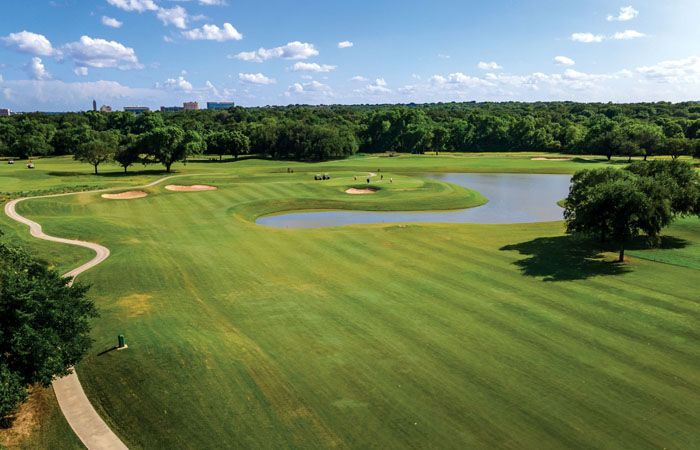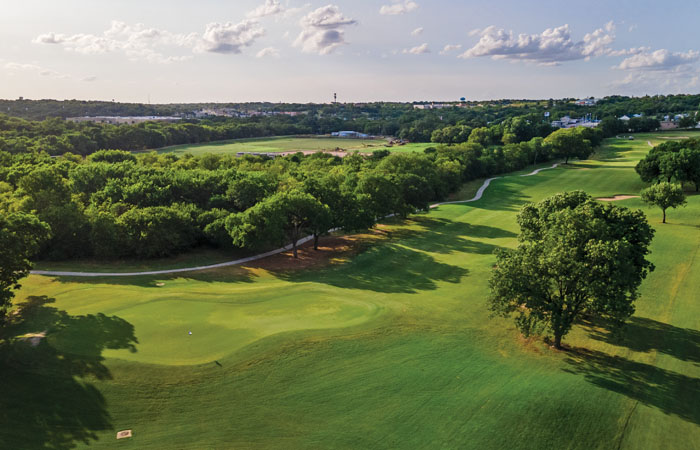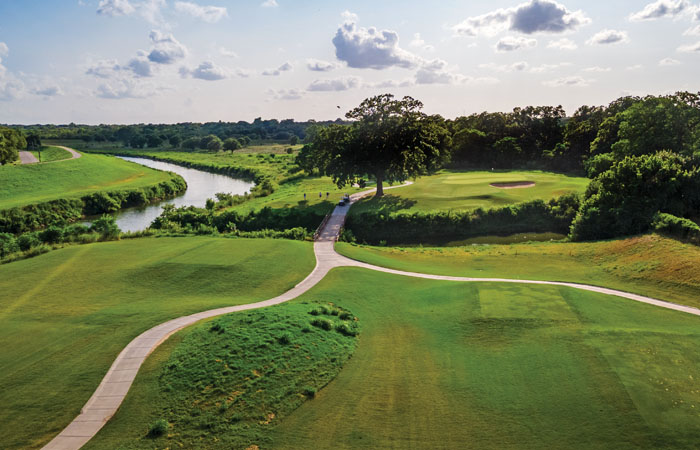When we last visited Rockwood in Fort Worth, the course had just undergone a multi-million-dollar renovation compliments of local architects John Colligan and Trey Kemp. In the three years since, the course has thrived as one of the top municipal options in the Metroplex. Now, a recently completed new clubhouse becomes the final piece of the resurrection of this Fort Worth staple.
The new clubhouse came with a price tag of $7.7 million, which was funded by the 2018 city bond program. The 16,379 square-foot structure has cart storage below the building and boasts and upper level with the new pro shop, a grill with dining area and a multipurpose ballroom that can be used for tournament festivities or other functions. The patio has about a dozen tables where players can sit in the shade and enjoy post-round food and beverages.
When Rockwood opened in 1938, designer John Bredemus used some of the natural topography to construct a course in between the Trinity River and Highway 199. Although the Trinity wasn’t brought into play much with the original design, when Ralph Plummer added a third “Blue Nine” in 1964, several holes played next to the iconic waterway, including back-to-back par-5’s, one of which stretched almost 700-yards along the river.

As the city continued to grow, the course saw changes, and when the renovation began in 2015, Colligan and Kemp wanted to take some of the holes from the previous 27 on the property and turn them into 18 great ones, which would not only challenge the low handicapper, but remained playable for the old school contingent that was loyal to Rockwood when it was struggling to survive.
The course is a great balance or risk/reward holes with a few curveballs scattered in. The course opens with a rather rudimentary par-4, which offers players a great chance to open with a birdie. Those who play a cut can aim at the left fairway bunker and carve a tee shot to the middle of the fairway, leaving nothing more than a short iron remaining to a green that is relatively tame by Colligan standards.
The first par-5 on the course is the second hole. This 533-yard hole can be tricky depending on wind conditions. A predominant south wind can make this one play about 40 yards longer, making it a lay-up hole. But a day where the winds are light or out of the north, and a good tee shot allows players to give the green a go in two. However, there is water short and right of the green, so be aware if you think about trying to secure an eagle putt.
The par-4 third is one of my favorite holes at Rockwood. There’s not much to it, other than a noticeable fairway bunker in the middle of the landing zone, but it does have a gorgeous view of downtown Fort Worth, so be sure to take a moment to soak that in before you stick a peg in the ground.

One of the requirements for potential architects when the course renovation was announced was at least one par-5 measuring over 600-yards. Colligan obliged with the 611-yard 4th hole. This behemoth features a narrow fairway that requires not only precision, but distance as well. Water on the right impacts any second shot toward the green or a layup. The best route is drive up the right center and then a second shot to the landing zone short and left of the green. Be mindful of a back pin here, as just beyond the green, there is a severe slope that will funnel balls into the water long of the putting surface. It’s a fun, but super challenging golf hole.
The first par-3 of the side is the fifth, and it is a tricky one. Although just a short or mid-iron for most, there is water on the right that can gulp golf balls that are slightly over-cut. Get scared and miss left, and players are left with a very tricky up-and-down to an elevated surface. Best play here, especially with a right pin placement, is to find the middle of the green and walk away with a simple par.
After the downhill par-4 sixth hole is one of the most interesting holes of this Colligan design. If you remember the old Red Nine at Rockwood, then you likely remember No. 2. It was an elevated tee that was just below Jacksboro Highway which sent tee shots down a hill to the awaiting green below. In a master stroke from Colligan and Kemp, they reversed the flow of this hole, and it now plays from the valley below back up the hill to an elevated green. Long hitters can challenge the green off the tee, but a deep bunker in front can be a nerve-racking up and down. This is true choose your own adventure hole, as players can also layup with an iron or play out to the left of the putting surface and hit a flip wedge in. There are multiple ways to tackle this hole, and that makes it truly intriguing.
In my opinion, one of the best par-3’s in DFW is Rockwood’s No. 8. This downhill 142-yarder features the mother of all false fronts. A cross bunker about 30 yards short of the green makes for an interesting mind’s eye view of the hole, and if you find the front of the green with a back pin placement, hold on tight, because it will take all your putting skill to walk away with a par.
The ninth hole is admittedly one of my least favorite on the course. Not because there is anything wrong with it, but because I am a cut player and this tee shot requires a hard draw. I inevitably must take a two-iron out of the bag and force myself to hit a punch hook around the overhanging left tree. It’s certainly a challenge for me, but for those right handers who play a draw, this one sets up perfectly. Another interesting element is the rectangular shaped green on No. 9. If you are familiar with Stevens Park in Dallas, which is another Colligan design, then you know he does like his squared off greens. This is the only one at Rockwood, but it’s a fun design wrinkle that is visually bizarre, especially when you are chipping from off the putting surface.

The inward nine has some holes and elements from both the old White and Blue nines at Rockwood. No. 10 is a par-4 with a slight dogleg right and a three-tiered green. Trees on both sides frame the fairway, so finding the short grass is a must here. Players might consider a three-metal to be sure they are in position “A”. This will leave a short approach where distance control is a key. The multi-tiered putting surface can be tricky if you aren’t precise.
No. 12 is the longest par-3 on the course, measuring at 233 from the tips. The good news is it usually plays with the wind and players can also use a severe slope to the right of the green to chase balls down on to the putting surface. Although it reads as a long hole on the scorecard, it doesn’t play as long as it seems. It’s a neat hole and with some creativity off the tee box, can be a chance for a birdie or easy par.
The first par-5 of the back nine comes at No. 13. In my opinion, this is one of the most gettable holes on the course. Again, this one runs south to north, so usually players have the benefit of the prevailing south breeze. A generous fairway awaits and with a good tee shot, balls can get plenty of roll out, leaving just a mid-iron to the green. Beware of the bunker short and left of the green, as it’s a bit of an optical illusion. Although from the fairway it appears to be greenside, it is actually about 15 yards short of the putting surface, which can leave the dreaded 25-yard bunker shot remaining should you wind up there. A smart play is to miss a little right of the green, as this will leave a simple pitch and putt for the birdie.
Out of the 18 great holes at Rockwood, I believe the fourteenth to be the most difficult. Although it is listed as the No. 6 handicap on the course, it can be tough for those of us who can sometimes lose one right. The wind is often blowing off the left, which means any ball that gets up in the breeze can disappear out of bounds, bringing a big number into play. Even a good tee shot leaves a long second, as the hole plays almost 460-yards from the back tees. It’s a tough nut to crack, but a good tee shot helps.
If you can recall the old Blue Nine, then you will recognize the next pair of holes. The final par-3 on the course is the 15th, which used to play as No. 2 on the famed Blue Nine. This 212-yarder is a long carry over a tributary of the Trinity to a green tucked among the tall trees. A bunker short is manageable if found, but a GIR here is a plus. It’s another great par-3 at Rockwood and one that comes complete with some nostalgia of what used to be.

No. 16 is a tight drive and the only remaining hole that nestles up to the Trinity. High fescue left prevents a bailout, so a great option here is a long iron or a hybrid to find the fairway and keep your nugget out of the river. This leaves a manageable approach to a slightly elevated green. Finding the fairway here is a must, as there is plenty of trouble to navigate.
After one final par-4, Rockwood’s ultimate hole is a par-5. This uphill, 557-yard hole is one final tough test presented by Colligan and Kemp. Usually playing into the wind, players can plan on adding some 50-yards onto the listed yardage with the incoming breeze and the uphill climb. Most players will choose a left to right ball flight off the tee to avoid a fairway bunker. This will leave a layup that will need to be short of the multiple cross bunkers about 40-yards short of the green. As if the hole wasn’t challenging enough, this hole features what I consider to be the most diabolical green on the course. Players will need to hit a precise wedge to find the proper portion of the green, or a two-putt can be next to impossible. And, as No. 9 is a perfect rectangle, No. 18 green is a perfect circle. You can go to GoogleMaps and check it out for yourself. It’s a fun way to finish and a hole that can see some two or three shot swings to even things out among your playing partners.
Rockwood has become one of the best municipal courses in DFW. It has so many great design elements and some of the best course conditions on the west side of the Metroplex. The rates are rock-solid (no pun intended) for the course and now that the new clubhouse has been completed, it’s a must-play for everyone. I never thought I would see Rockwood become what it is today, but I must say, it’s fantastic.
Rockwood Park Golf Course
1851 Jacksboro Highway
Fort Worth, TX, 76114
817-392-6560
www.FortWorthGolf.org